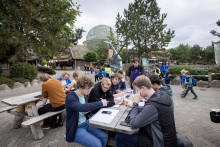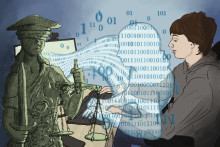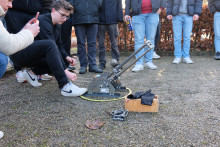Amusement park Slagharen. Once a territory for ponies, it remains the domain of school classes and day trippers to this day. A place of spinning, turning, screaming and yelling. However, this day is also about studying.
The second-year Mechanical Engineering students left by bus from the Spiegel for Slagharen this morning. Students from both the UT programme and the joint bachelor degree with the Vrije Universiteit in Amsterdam joined in. ‘It's fun to be here regardless,’ says student Tjerk Zweers at the main entrance of the amusement park. ‘But it should also be a learning experience.’
Field trip
As cheerful as Zweers sounds on Friday morning, similarly welcome are the cups of coffee and filled cakes to many of his fellow students at the American Circus Theater. On the stage where ponies paraded in the not too distant past, now stands assistant professor Jurnan Schilder, who is also the initiator of the amusement park visit. ‘It feels like a field trip, doesn't it?’ he asks his students. ‘But many of the rides we visit are excellent examples of dynamics. I would say: go on the rides, so you can also experience the forces you calculate.’

Before the students split into groups to experience the forces expressed in various amusement rides in the park up close, they receive a lecture from Schilder. For example, he explains the G-forces you are subjected to during a roller coaster ride, as well as the structural integrity of the construction itself, where the weak spots are usually at the welds and bolts. Before they know it, the teacher is chalking up his screen with free-body diagrams and equations. All in order to dissect the forces released during a swinging ship ride.
Screaming kids and calculators
The students then make their way in groups, accompanied by Schilder's colleagues, toward the park's rides. The group accompanied by doctoral student Luc Keizers reports to the Tomahawk, a so-called spin 'n puke ride for the connoisseurs. For this assignment, the students only need to pay attention to the linear actuators, observing how the rotational motion of the motor is converted into a straight push or pull. Keizers advices students to observe carefully first, to only then draw out the problem on paper.
Not before long, a remarkable contrast unfolds: a screeching school class flying by in the Tomahawk, in the face of students busily poring over diagrams and equations on their notebooks or drawing tablets. On the other side of the park, at the Apollo whirligig, the picture is no different: hyperactive children run past Mechanical Engineering students who have littered a picnic bench with calculators, notepads and a bag of pepernoten.

‘Calculations must be correct’
The dynamics become even more complex at El Torito, a so-called octopus attraction where the forces are exerted in X, Y, and Z directions. ‘The beginning of the task is doable, describing how the elements move,’ student Job Nahuis explains on the spot. ‘But I'm a little afraid of the kinetics, calculating how the movements are connected. And of course the setting is different from a lecture in the Waaier. Now we approach it the other way around: instead of drawing from a calculation, we see an attraction moving where we have to figure out the underlying calculations ourselves.’
That is exactly one of the reasons for walking around here with some 150 students, Schilder says. ‘Of course it's more than a field trip, students are working hard here. This is a place where you see a lot of fun around you, but it is all about something that matters. The calculations for such rides must be correct, otherwise people will die.’ The closer Schilder can bring reality to his students, the better. ‘Such a complex device can be daunting, but if you sit down for a moment, you can flatten all those movements into a number of equations on paper.’
In the clouds
Fortunately, there is also some time between the calculations for students to take a ride on a roller coaster, log flume, free fall or whirligig. The Spanish trio of Irene Encina, Lucas García and Alberto Marques just got off the whirligig and are in the clouds with this unorthodox day of classes. ‘People around me sometimes ask what kind of job I could do after this study. Well, designing something like that,’ says Encina. ‘It would be cool if we could go on a field trip to an ride builder later in our studies,’ Marques adds. ‘Seeing and experiencing it helps to calculate the dynamics, although it is tough matter,’ says Garciá.
Moments later, the trio is in queue for the launching coaster Gold Rush. Calculating what G-forces a body has to endure is one thing. But experiencing it in person, that is what gives you a thrill.







